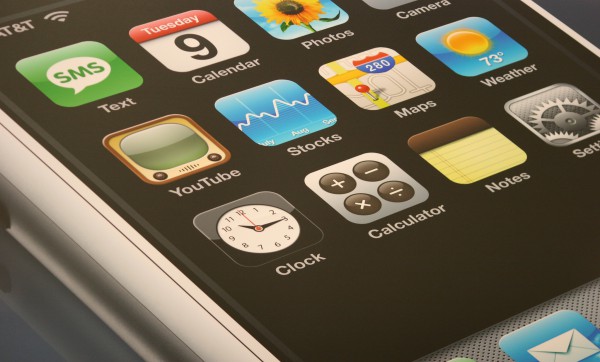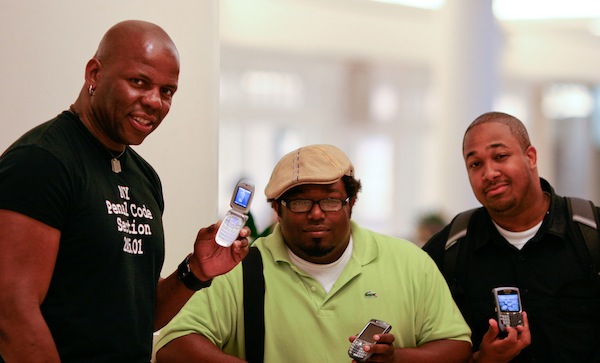iPhone is iconic

Happy Birthday! iPhone is 8 years-old today. Oh my, it seems so much longer ago because so much has changed. Think back. Eight years ago, there was no Android. YouTube was but 18 months available to the public, and Facebook or Twitter only about a year. There was no market for tablets, or smartwatches.
The iPhone marks everything right about the Steve Jobs era of risk-taking design. More changes: He is gone from this world and some of that other-worldly innovation with him. In 2007, the smartphone was a decade-old slow seller that few people owned. Now it's everywhere! Apple deserves credit for the transformation, whether or not anyone wants to give it.
I debated whether or not to post this observation and do so with trepidation. I don't want to take away attention from colleague Wayne Williams' superb recollection "8 years ago today the iPhone went on sale and changed everything—so why didn't I want one?" Problem: The anniversary is but a day, so I slip this one in hoping to draw attention to his work. Stop reading mine. Click, click Wayne's.
Human Touch
Oh? You finished Wayne's masterpiece and want more iPhone memories? Then let's start with a reminder about the fundamental design ethic that makes iPhone iconic.
Apple's approach to computer/device design is consistent and pervasive: Humanization of complex technological products. There has been much written about the design ethic in context of products that look good. But there is something more fundamental: Designing tech that is easy to use by making it more an extension of the human being—more part of you. Apple's design ethic is understated, while minimizing complexity.
This characteristic is what made iPhone matter when launched on June 29, 2007. Nokia invented the smartphone in 1996, but Apple reinvented it by cleverly incorporating sensors and capacitive touchscreen that made the device responsive—more human-like. Nokia and Research in Motion led the market category eight years ago, but now they're laid waste.
Human beings are tool users who experience and manipulate the world through five senses. Apple products appeal to the eyes through design, whether it's the software GUI or hardware appearance. But the eyes are passive instruments. Hands and fingers are more important because they are active—they're how people tactilely manipulate the world around them. People examine objects they desire as much with their hands as their eyes. Watch how someone interacts with items for sale—first look, then touch.
Too many technological devices are too difficult to use because they expose too much complexity. Compare to the human body: The underlying biological mechanisms behind hand movement may be complex, but for most people the complexity is largely hidden. The keyboard is unnatural user interface; it exposes too much complexity. There is little in human biological or cultural experience that supports use of the keyboard. It's a particularly unnatural construct, in which organization is based on the number of times letters are likely to be used. The mouse is more natural than the keyboard, because of the hand and finger-clicking movement. But the mouse is still a makeshift extension of the human being.
The finger and touch are more natural, because they extend you. Good user interfaces build on the familiar—and there is nothing more familiar than me, myself, and I. See, say, hear, and touch. Apple’s approach to non-Mac devices—Apple Watch, iPad, iPhone, and iPod touch—more naturally extends the hands, fingers, eyes, and even mouth (for voice response). Successful user interfaces of the future will have similar attributes.
That said, Apple needs to transcend touch and better embrace voice. As we move further into the contextual cloud computing era—Post PC is a myth of Apple’s making—touch interfaces should cede way to voice. Touchless should be the primary UI. Speaking is even more intimate and human than touch. Homo Sapiens is a natural communicator, and the species is inherently gregarious.
Risk and Reward
There was something almost insane about the risk Steve Jobs and Team took in 2007. Many people expressed skepticism. Apple embarked into an established market with entrenched competitors, with no experience making cell phones and selling through a single carrier (AT&T, which was Cingular before the launch) in one market (United States).
There were risks all around:
- AT&T bet the brand on the one device
- Sharks—Nokia and RIM, namely—surrounded Apple
- iPhone sold, locked and unsubsidized, for $499 and $599
Who would pay unlocked-mobile prices for a device that wasn't? One million people through early September 2007. For these early buyers, and perhaps for bazillion more who followed, the handset isn't a phone so much as cultural phenomenon.
This dramatic change started from the iPhone moment, when a perceptive set of people looked ahead to a different future. That's what I recall most about the smartphone's launch outside Apple Store Montgomery Mall in Bethesda Md. One buyer told me that the launch would change everything, and we would look back on the moment in 10 years or more and see so. Well, it didn't take nearly that long.
I wrote the following morning: "The people I talked to in line yesterday had a sense of being caught up in a historical moment". How true is that today. Cell phones look little like they did eight years ago. In a two-paragraph post made hours after the iPhone launch, I wrote about the three men pictured:
I really love these guys. They were typical of the very atypical crowd waiting for iPhone. If there were geeks in line, I didn’t find them. But there were plenty of regular people, which says something about iPhone’s broad appeal and the cell phone market in general. Mobiles are gadgets for the masses, not geeks.
What they wanted: A better-designed, more intimate and personal cell phone. Touch is transcending and the sensors that made—makes—the device more human-like. Sales tell the story. During first quarter 2015, Apple sold 60.18 million iPhones, according to market researcher Gartner. In China, where iPhone is market leader, year-over-year sales soared by 72.5 percent. Apple is second-ranked, based on sales, in smartphones and all phones, behind Samsung in both categories.
During the same quarter, iPhone accounted for stunning 69. 4 percent of all Apple revenues—up 57 percent from 12 months earlier.
It all started eight years ago today.
Photo Credits: Joe Wilcox

